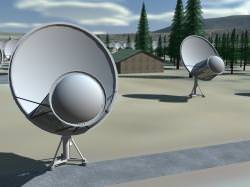The biggest and best tool ever developed to search for signs of extraterrestrial life is coming online in Northern California. No, it’s not an interstellar bounty hunter, it’s an array of radio dishes in Northern California. The Allen Array, located in an arid valley near the town of Hat Creek started gathering data with 42 radio dishes today. But that’s just the beginning; eventually there’ll be 350 dishes pointed to the heavens, listening for the faint communications from an extraterrestrial intelligence.
Partly funded by Microsoft co-founder Paul Allen, the Allen Telescope Array released its first test images today. These included a radio map of the nearby Andromeda Galaxy (M31) and the Pinwheel Galaxy (M33).
Although the array was used to capture radio images of galaxies, one of its primary roles will be to search for communications from extraterrestrial civilizations. It works on the idea that many smaller radio telescopes working together are more powerful and cheaper than a single large dish.
Over the next couple of decades, the Allen Array will gather 1,000 times as much radio data from distant stars as has already been accumulated in the 45 years of the SETI program. Astronomer Seth Shostak from the SETI Institute made a bold prediction, “I think we will find signals from intelligent civilizations by 2025.”
The total cost of the project to date is $50 million. The first phase of $25 million was funded by the Paul G Allen Family Foundation. Another group of donors contributed the additional $25 million. UC Berkeley and the SETI Institute are now working to raise the funding to complete the full 350-dish array.
The final 6-metre (20-foot) dish should be completed in approximately 3 years, bringing the full array online. The aliens won’t be able to hide from us much longer.
Original Source: UC Berkeley News Release
What is the biggest telescope in the world?

